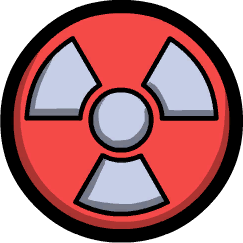 |
This article has not been revised for the current version (U51-600112). It was last updated for LU-356355. It may contain inaccuracies. |
Thermo Regulator cools the Gas piped through it and absorbs the Heat.
If the environment around the Thermo Regulator cannot absorb its heat, it will quickly overheat. Unlike a Thermo Aquatuner, it cannot be submerged in liquid, though liquid under 350kg/tile (Flooding status) can be used to facilitate faster cooling.
- The tiles that the Thermo Regulator is sitting on can be Mesh Tiles, however, so there can be liquid (and gases) underneath the Thermo Regulator.
- The Thermo Regulator cannot be immersed in liquid, but it can still be immersed in gases, including Steam.
Mechanics[ | ]
Thermo Regulator (as well as the Thermo Aquatuner) works by taking heat from anything piped into it and applying that heat to itself, and does not produce its own heat. As this is heat-neutral, cooling it with its own output will cause it to maintain its temperature, assuming no other heat sources or sinks are present.
The amount of heat moved depends on the type and amount of gas piped in. Each packet of gas has 14 °C removed from it, regardless of the specific heat capacity of the gas or the amount. It is therefore best to use gases with a high SHC (Hydrogen) and to ensure all packets sent in are 1 kg (it consumes 240 J per packet, not per 1 kg), in order to make the most of the 240 W power requirement.
The Regulator does not respect condensation temperatures of gases, and will damage the output pipe if gases are cooled below their condensation temperature.
Whilst the Regulator has no minimum output temperature, it is hardly capable of producing liquid hydrogen, as hydrogen has the lowest condensation temperature and therefore cannot be produced without damaging pipes. It can produce liquid oxygen, but a Thermo Aquatuner is more efficient if you have access to Super Coolant. Though as of Meep's Mandatory Recreation Pack Update Hydrogen liquifying can be achieved using the fact that cooling 1/10 of maximum packet size of gas below its condensation point will not break the pipe.
| Name | Specific Heat Capacity (DTU/°C)/g |
Heat Moved DTU/s |
Self Heating °C/s for Steel |
|---|---|---|---|
| Oxygen | 1.005 | 14,070 | 0.144 |
| Hydrogen | 2.4 | 33,600 | 0.343 |
| Steam | 4.179 | 58,506 | 0.598 |
| Super Coolant | 8.44 | 118,160 | 1.209 |
Any gas can be used, but Hydrogen is the best option as it has the lowest condensation temperature and a high heat capacity. Steam and Gas Super Coolant are higher, but are also high temperature.
Comparison to Thermo Aquatuner[ | ]
The Thermo Aquatuner is similar to the Thermo Regulator, but processes liquids instead of gases. While both machines reduce temperature of their working fluid by the same amount, the Aquatuner moves considerably more heat. Common liquid coolants tend to have higher specific heat capacity than gas coolants when their temperature ranges overlap, and even with the same SHC the different throughput of liquid versus gas pipes means that e.g. a Thermo Aquatuner cooling Water will move ten times as much heat per second as a Thermo Regulator cooling Steam.
In terms of bulk heat movement, then, the Aquatuner is the clear winner, as it moves 10x the heat for only 5x the power and 6x the material. Conversely, the Aquatuner heats up 10x faster, so it needs to have much more of its own cooling or nearby thermal mass to keep it from overheating, even with its higher base overheat temperature and the superior thermal properties of Refined Metal. The smaller power demands of the Regulator may also make it more desirable for smaller-scale or short-term cooling efforts.















